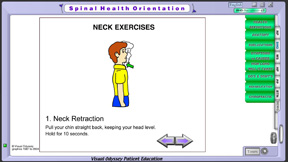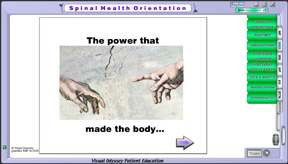 |
The first button,“health definitions,”starts off with the “innate” button. This is where we have taken Michelangelo’s picture of God enabling the spark of life to Adam, and we’ve bound it with the concept that made the body. |
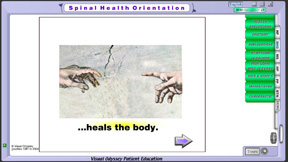 |
It’s this power in the body that has the power to heal the body. This is a great way to open the talk. From there you could go to a number of different subtopics within the health definitions. |
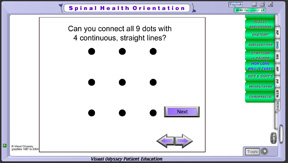 |
The nine dot screen is a famous way to start a discussion and get people to start thinking outside their normal thoughts. |
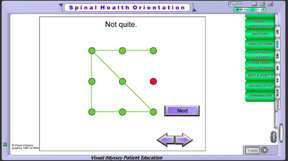 |
The first thing we do is show four solutions that are unsuccessful at the concept of connecting all nine of these dots by using only four straight lines without “taking your pencil off the paper.” |
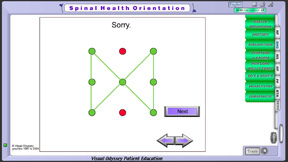 |
|
| |
The final solution is the solution that works, but notice, the only way it works successfully is when you’re willing to think outside the box, or in this case when you actually draw your straight lines outside the box. Also, notice that there is now a right arrow in the lower right hand corner of that screen. That is very similar to flipping the pages of our flip chart, so as I’m going to cycle through that, I’m going to give discussions on how to use these different screens as your explanation about chiropractic. |
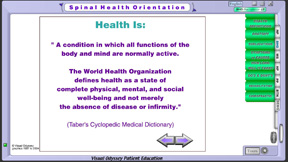 This screen shows six different facets of health. As you click on each of them, there is a little subheading underneath that helps you talk more fully about each of the parts that make up total or a complete sense of wellness.
This screen shows six different facets of health. As you click on each of them, there is a little subheading underneath that helps you talk more fully about each of the parts that make up total or a complete sense of wellness. |
The “Health Is:” page provides an accurate definition of health. This gives you the opportunity to redirect people to realize that health is a matter of complete physical, mental and social well being, and not just merely the absence of disease or infirmity. Too many people judge their own health based upon whether or not they’re in pain. We need them to understand that this is not what health is all about. How often does someone who feels fine, suddenly, and unexpectedly, die? |
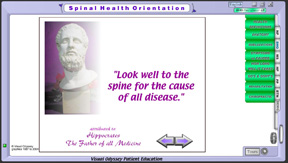 |
|
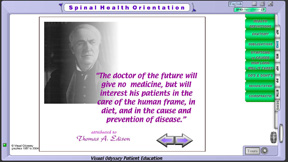
This quote has been attributed to Thomas Edison. Of course this is a very important consideration with respect to what health really is. This is the basis for Chiropracic care. |
As we click to the next screen, we have the famous quote that is attributed to Thomas Edison. This gives you an opportunity to talk about the importance of the human frame (which is what we think of as the skeletal and muscular structure) and in the importance of proper diet, and cause and prevention of disease. In other words, if we don’t give the body proper fuel, or your body isn’t structurally sound, then we are not truly looking at the causes of disease and how we can prevent them. We’re really not focusing on what the doctors of the future are focusing on. It’s medicines for the most part that are used to help symptoms rather than get to the root cause. |
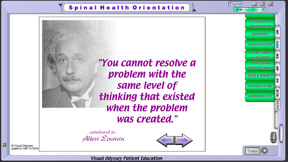 |
|
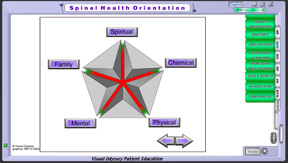 |
|
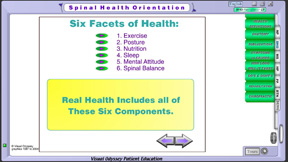 |
Health has six basic components. To be totally healthy, you have to dedicate yourself to proper exercise, good posture, good nutrition, restful sleep, a positive mental attitude and a well balanced spine. Of course you want to spend a little time on each of these topics with your patients, such as explaining how exercises should be done properly, how good posture reduces stress, and how nutrition is a matter of “you are what you assimilate.” We also want people to realize that the body heals itself while sleeping and that no one ever gets well unless they really want to. |
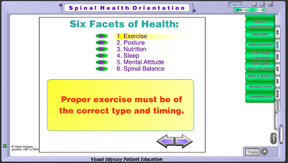 |
|
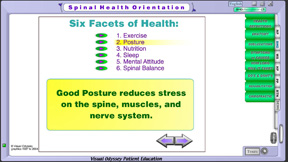 |
|
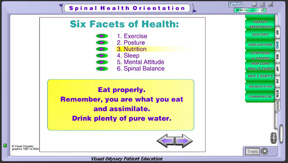 |
|
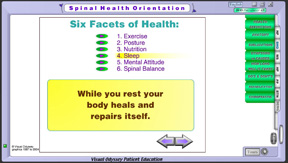 |
|
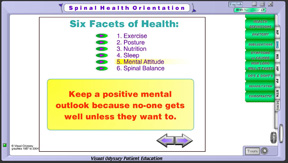 |
|
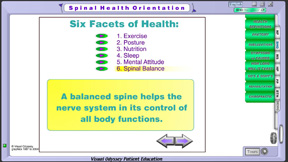 |
|
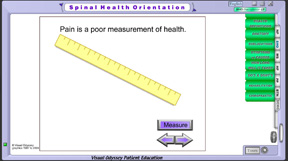 |
|
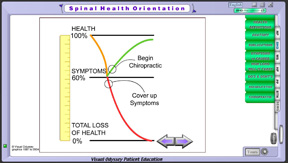 |
|
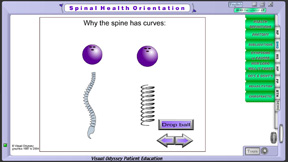 |
Now, moving into the “anatomy section” we begin very simply with, “Why does the spine have curves?” |
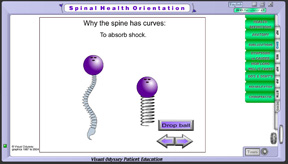 |
We show a side view of the spine with a spring, and dropping the bowling ball to help illustrate how the spine, with its curves, enables the body to absorb shock. Another reason for using the bowling ball is that the weight of a bowling ball is not unlike the weight of the head, and this also helps people understand the importance of a neck curve and having the bowling ball as if it, or the head, were directly over the shoulders as opposed to having the head out in front of the shoulders where the weight is constantly going to be pulling down on the neck. |
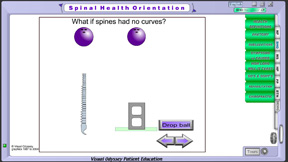 |
When we click to the next screen and drop the ball, we see that a rigid or straight structure cannot absorb shock, and the result over time is that we are going to have serious problems. |
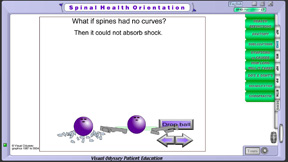 |
|
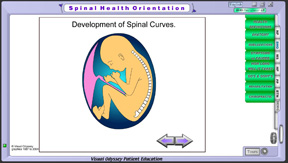 |
The next few screens give us the ability to demonstrate that these curves of the spine, when viewed from the side, aren’t something that develop completely before you are born, but they develop as the musculature does. It is very important that babies are given an opportunity to crawl before they are forced to walk because that gives all of their musculature the opportunity to develop as it should, to support the spine. |
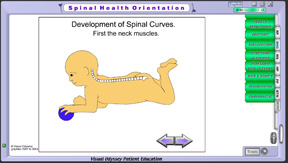 |
|
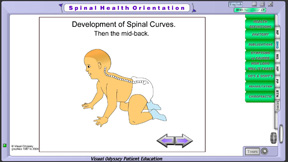 |
|
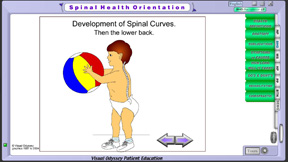 |
|
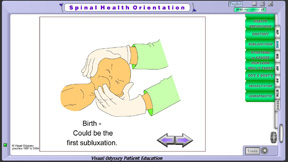 |
Then, we deal with a few issues that, very early on in life, can impact the proper development of the spine. Of course, there is birth, which (for many children) is their first subluxation. |
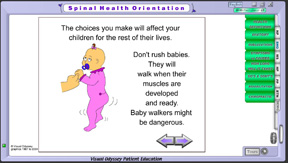 |
Or, forcing children to walk before their muscles are fully developed, this also gives you an opportunity to discuss the dangers of walkers, not only from the perspective of falling down stairs, but also from the perspective of getting children to apply too much weight on their legs and their lumbar spine before they’ve adequately developed the supportive musculature. |
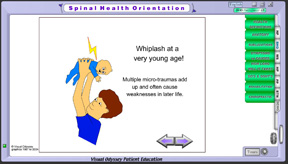 |
Then, we show a picture of a baby being thrown up in the air. This always brings an interesting response from the audience, frequently it makes people nervously laugh, this also helps people understand why we utilize characters and cartoons rather than photos. |
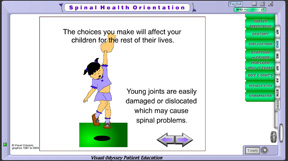 |
We can get across a very powerful point in a humorous way, and at the same time people walk away with an understanding that this is not something that should be done. Over time these microtraumas can build up and cause weaknesses in the spine which might show up later. Another example of structural abuse is parents who use the arm of a child for lifting and carrying the child because this definitely can weaken the shoulders and as well as cause other spinal problems later on. |
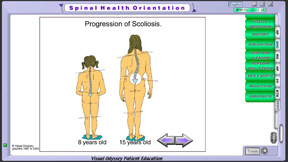 |
|
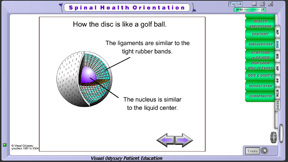 |
The next section within the “anatomy section” is the discussion of the discs. The disc, as we know, provides structural shock absorbtion. It absorbs the shock between the bones. The first thing we do is utilize the analogy of the golf ball because we are demonstrating that discs have a liquid center, and many golf balls do as well. The golf ball center is contained by these very tight rubber bands that are wound all the way around it. |
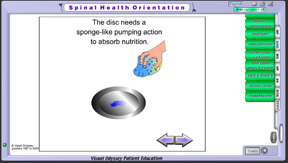 |
One of the things we want people to understand as we click through this, is that a disc needs a sponge-like pumping action. That’s how it sucks nutrition into the disc, especially as people get older because there is less and less blood supply getting to the disc. |
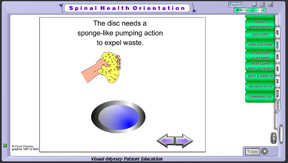 |
Also, we need this sponge-like pumping action to expel waste products from the disc. So we demonstrate a little bit of motion in the disc in a side view and when we click again we see a cross section of the bones and a cross section of the disc to get this point of fluid transport across to the audience. |
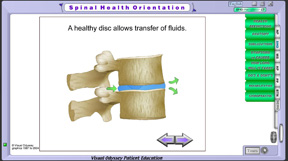 |
|
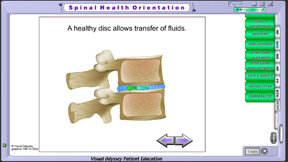 |
|
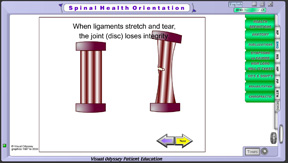 |
|
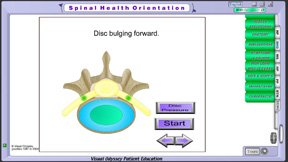 |
|
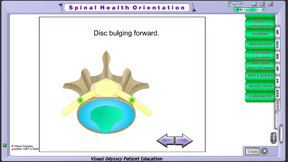 |
|
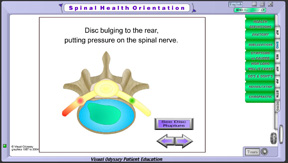 |
|
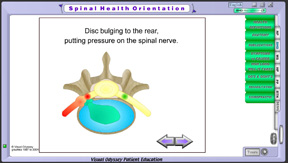 |
|
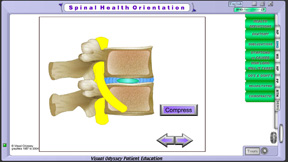 |
Then we show a side view of the disc and the compression putting pressure on the spinal nerve. Now we have a number of options. |
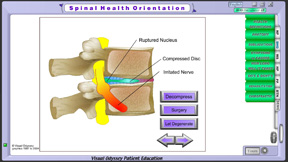 |
The first option is to not do anything and let the area degenerate. We then show the degenerative changes to the bones as well as to the disc. Click to let it degenerate further and you’ll see the atrophied nerve, compressed disc, and the ruptured nucleus. Of course the thing that makes the most sense is to actually utilize chiropractic for the purpose of decompressing the disc, and if appropriate, other modalities like a decompression table to help restore the health to that disc area. |
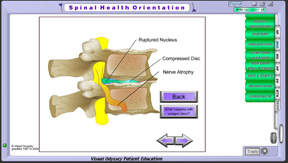 |
|
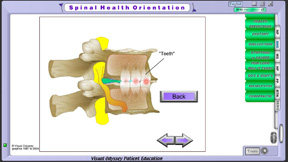 |
|
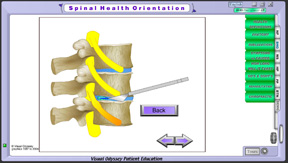 |
Another option we can click on is surgery. This animation demonstrates how well surgery may help with the initial symptom complaint, but it also has the additional problem of locking up that specific joint and forcing an excess range of motion in the areas above and below, this causes additional wear and tear of the spine. It’s one of the explanations for why back surgery can often fail, because the problem will travel to another area of the spine. |
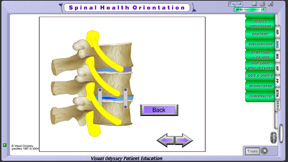 |
|
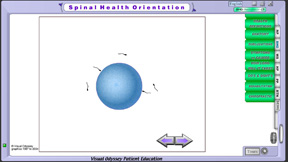 |
When life begins with a fertilized egg, there is cellular division. That division continues until something differentiates. Suddenly, there’s something there which makes it more than just a mass of identical cells. That first thing, is a very primitive nervous system. It’s the primitive brain and the neural streak which becomes the spinal cord. The reason why the nerve system is the first thing to develop is because it’s responsible for bringing the spark of life to each cell of the body. As a matter of fact, off of each of these areas of the nervous system, are little buds. Those buds become the organs of the human body as further development takes place. |
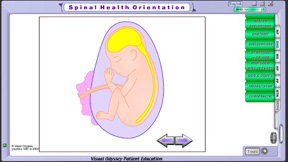 |
|
| |
|
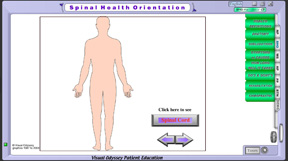 |
We have created a form of overlay systems similar to our flip chart. In this section you click and show the body outline and then you add the spinal cord after showing the brain and spinal cord we show the rest of the central nervous system, and the spinal nerve distribution, then we show how the spine is actually this movable armor that is protecting the spinal cord which is so critical to all the function of the body. |
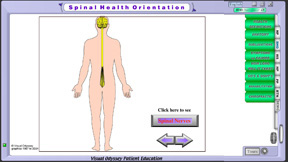 |
|
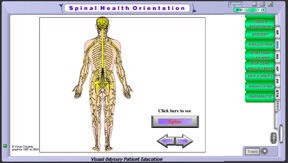 |
|
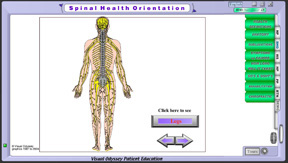 |
We then add the other skeleton structures: the arms, legs, the ribs, the shoulders, and then finally the skull. The skull is that part of the armor containing the most important organ in the body, the brain. Then we show the muscles, this gives us the opportunity to talk about how the brain uses those spinal nerves to be able to communicate to each of the muscles. It’s this communication process that allows us voluntary motion as we choose to contract certain muscles and “tell” the other muscles to relax. This is how we are able to clench our fist or open our fist. |
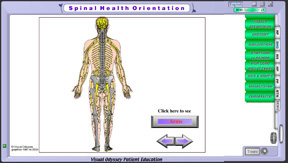 |
|
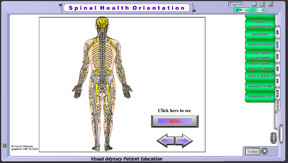 |
|
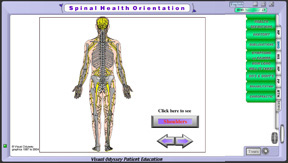 |
|
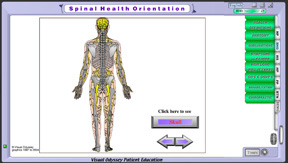 |
|
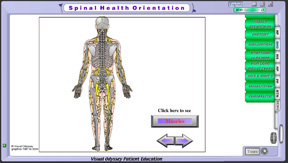 |
|
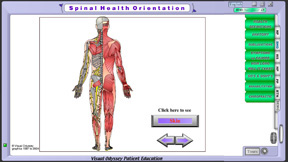 |
|
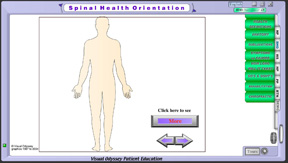 |
The last picture is the skin and this is where we talk about how those nerves come out through the muscles to the surface of the skin to allow us to feel or sense our environment. We sense cold, numbness, tingling, pain, and those sensations travel from the nerves on the surface of the skin back through the spinal nerves to the spinal cord and up to the brain where it registers that type of sensation. |
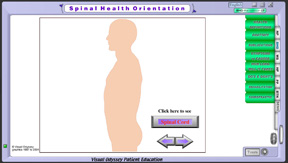 |
Then when we click to see “More” we see a side view and then again the brain and the spinal cord, and show some of the cranial nerves going out to the face , next we add the spine which protects the spinal cord. |
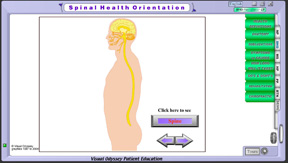 |
|
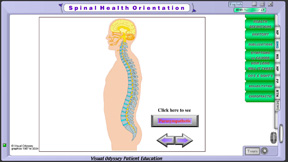 |
|
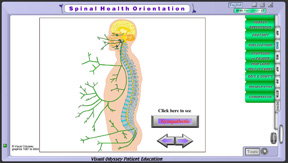 |
Then we show the two parts of the autonomic nervous system, the parasympathetic nerves and sympathetic nerves, and then we show the organs that those are connected to, like the brain’s ability to communicate with the muscles and the skin, the brain also has to communicate with the organs in the body. It works a little bit like an orchestra, if the brain is the conductor and the organs are the musicians, the conductor must be able to hear the musicians to be sure they are all playing in tune. The musicians must be able to see the conductor. That’s how they are able to play in concert with each other. |
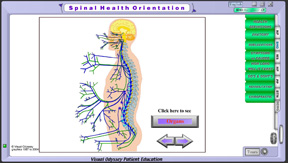 |
|
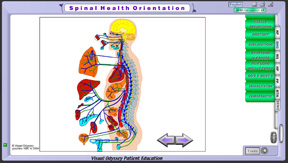 |
|
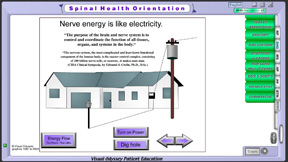 |
The next screen is where we utilize the analogy of electricity for people to understand how the nerves function and what it is they are transmitting: a chemical form of electricity from the brain and out to all parts of the body. |
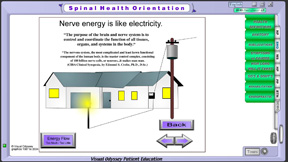 |
When we click on the button that says “turn on power” we see electricity going from the electric company, through the house and out to the light in the front yard. |
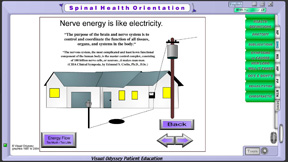 |
If we click the “back” button and we click “dig hole” this shows how a disturbance along the circuitry impacts certain parts of the body and, in this case, the house, but not impact others. This also gives you the opportunity to bring up the discussion about ‘symptoms versus cause’ because It is very clear, until we actually restore the proper circuit we will not be able to restore light. You can explain to the audience that you can replace this light bulb in your front yard as often as you want, but it’s not until you fix the problem with the wire that you are actually going to get that light to come on. |
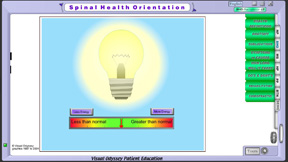 |
|
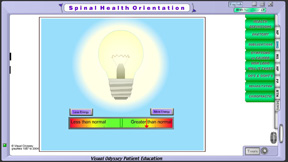 |
|
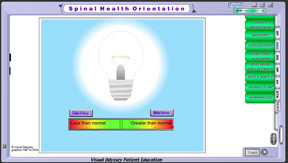 |
|
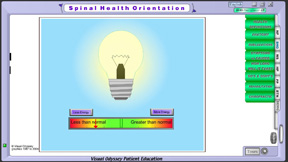 |
|
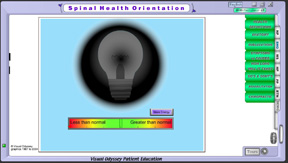 |
|
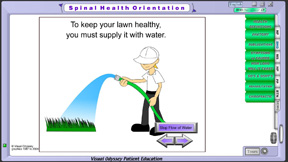 |
|
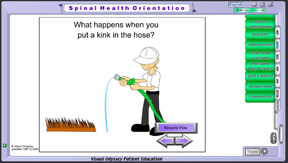 |
|
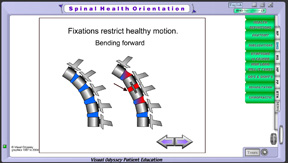 |
Then we deal a little bit with definitions of what is a subluxation by starting with fixations. We have three animations that show bending forward, bending to the side, rotational fixation, and how that keeps that area of the spine from functioning properly and forces an excess range of motion and wear and tear on those areas above and below the fixation. |
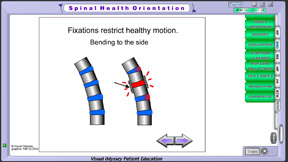 |
|
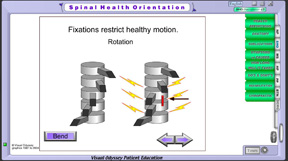 |
|
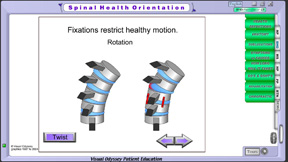 |
|
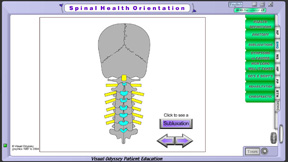 |
We then show a dramatized image or animation of a bone moving out of position and impacting the normal health and function of those nerves and that area and their ability to send signals properly from the brain and to the parts of the body that those nerves are designed to control. |
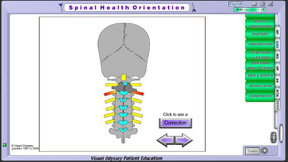 |
|
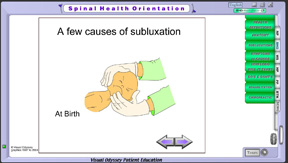 |
Next, we have many different images of causes of subluxation. Never in a talk would you use all of these, but when you are creating your own custom presentation it is very beneficial for you to be able to choose just those that are specific to your audience. It’s also possible for you, when you click on the “subluxation” button and then you click on the “causes” button to go ahead and actually show the specific cause that a patient might have. This enables you to nonlinearly jump to the exact image that you want to get across. |
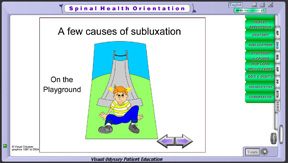 |
|
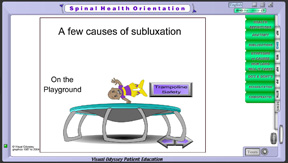 |
|
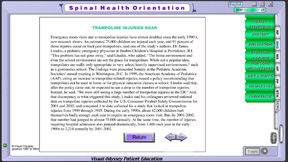 |
|
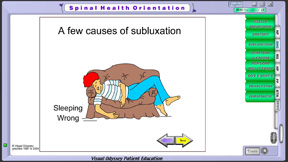 |
|
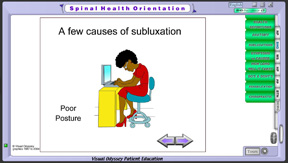 |
|
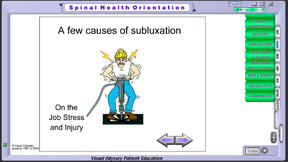 |
|
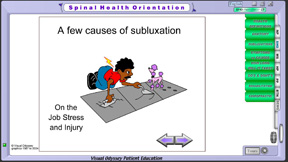 |
|
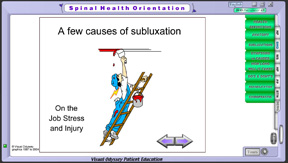 |
|
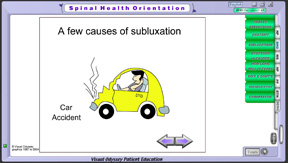 |
|
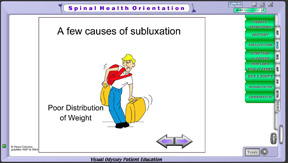 |
|
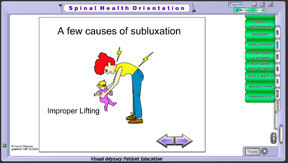 |
|
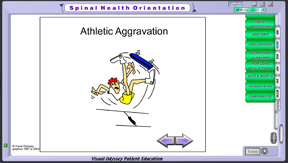 |
|
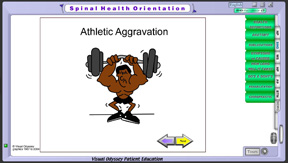 |
|
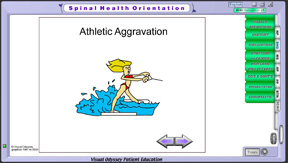 |
|
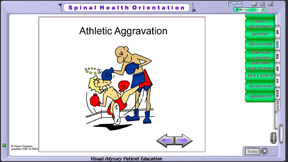 |
|
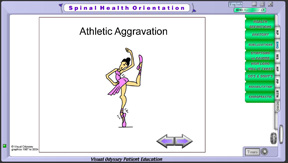 |
|
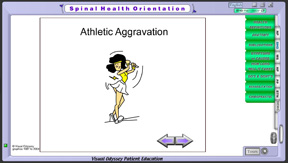 |
|
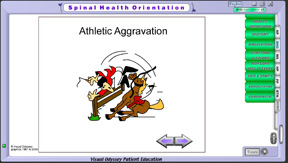 |
|
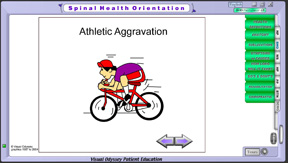 |
|
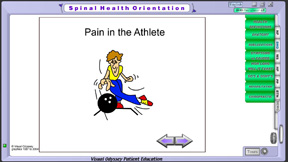 |
|
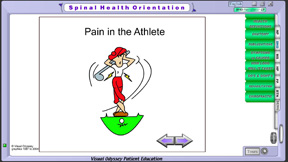 |
|
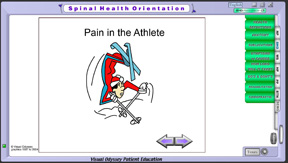 |
|
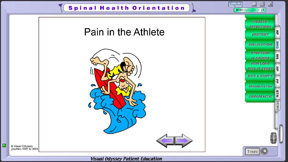 |
|
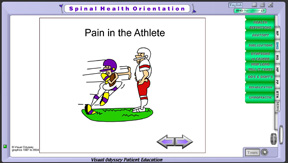 |
|
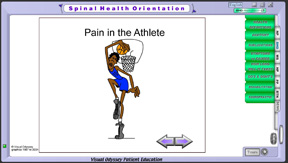 |
|
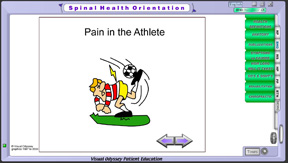 |
|
| |
|
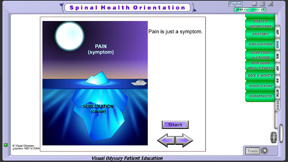 |
What do most people do when they have a subluxation? Most people, unless it was trauma, aren’t aware of their subluxation until they have pain. We tend to be a society that focuses very heavily on pain. It’s one of our major motivating factors. You must understand that pain is really just a symptom. And as such, it’s frequently just the tip of the iceberg. Here we have the subluxation, or the cause, and here we have the pain. Most people do what they’re told to do. They listen to TV, and TV tells them if you have pain you should cover it up with drugs or aspirin. |
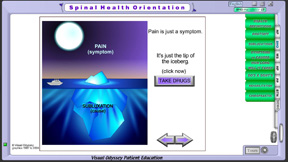 |
Now, in the next section “symptoms versus causes”, you have more different images and animations then you would use use at one talk. You would pick and choose those that are most in alignment with your way of discussing chiropractic and add those to your custom presentations in the place that you feel will best get your point across. It’s a good idea to use a few of these throughout your talk the first one is the classic “tip of the iceberg” one. First, you click the button to start the boat as you talk about how pain is just the tip of the iceberg, it’s only a symptom, it’s what’s visible; what you are aware of. There’s always an underlying cause for pain and if that cause is a subluxation, taking drugs merely sets you up for more serious problems down the road, because you are ignoring the actually underlying cause, and instead you are dealing strictly with symptoms. |
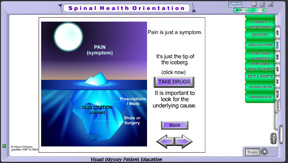 |
|
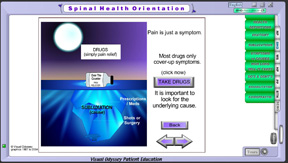 |
As a result, they cover up the pain, and do nothing for the cause. If the cause is a subluxation, I think you can easily see that this is a mechanical problem that requires a very specific mechanical solution that only a Chiropractor can offer. A generalized chemical solution is not going to be able to resolve the problem of a subluxation. Drugs may be convenient and inexpensive, but there’s a much greater cost to taking the symptomatic approach and hiding the pain? |
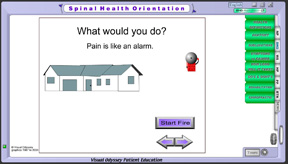 |
As we click to the next screen we have one that is frequently used to end the talk because it gets the patient to make a decision. We show a fire, and talk about how there are two ways to deal with this. |
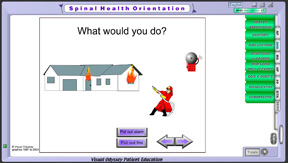 |
One is to “put out the alarm”, obviously that doesn’t make any sense and yet that is what people are doing all the time when they are taking drugs to deal with pains and symptoms. So, when we click the “back” button and click “put out fire” we’re helping them understand that that really is a more reasonable approach to the problem, but what they choose to do, is really up to them. Now that you have presented all this information, certainly your hope is that they will be cause oriented and utilize Chiropractic rather than strictly symptomatic approaches and the degenerative process that leads to. |
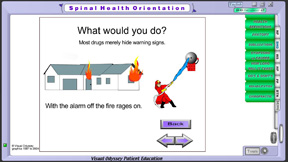 |
|
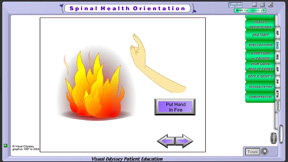 |
The hand in the fire gets this same point across, that taking drugs isn’t going to do anything to actually resolve the problem. What we need to do is to remove the hand from the fire. |
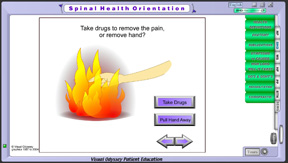 |
|
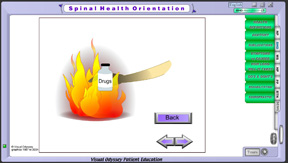 |
|
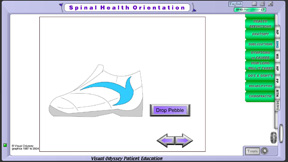 |
The pebble in the shoe is similar, what would we do? Would we put foam in the shoe so the pebble wouldn’t bother us? Would we instead walk around with a cane? Or would we actually remove the pebble from the shoe? |
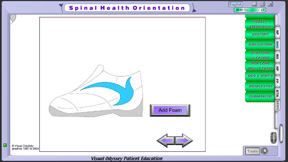 |
|
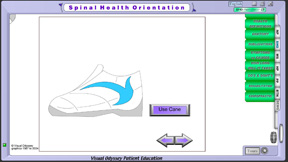 |
|
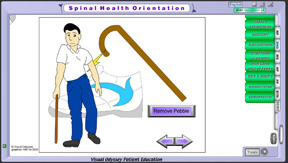 |
|
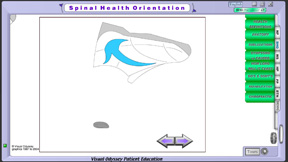 |
|
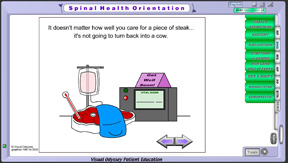 |
|
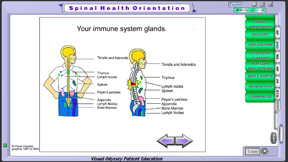 |
The next section of this gives us the ability to go beyond symptoms, pains, and things like that, and instead to deal with something very important to the body and its ability to defend itself. People are highly aware of the immune system now, much more than they were in the 60’s, 70’s, and 80’s. What many people don’t realize though, is that the nerve system is a critical part of the immune system. It works just like radar would work in helping us be aware of some sort of attack. If we have dysfunction of the nerve system, then the body doesn’t clearly know what’s going on, and as a result it cannot rally to the defense. Chiropractic works to improve nerve function and as such, the body stands a much better opportunity to defend itself against different types of invasions or attacks. |
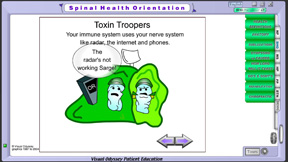 |
Not only is the Chiropractic approach to removing subluxations appropriate for pain relief and helping to prevent further degeneration, it is also very important for maintaining health. Everyone is very aware of the importance of the immune system these days. To better understand how it all functions you must realize that for the immune system and glands, to rally to the defense of the body, they must be aware of an attack. This is where the nerve system plays a critical role. The nerves act as a radar system to detect an invasion and to alert the organs and glands that will protect the body. It stands to reason that anything that interferes with normal nerve function will hinder your body’s ability to respond. |
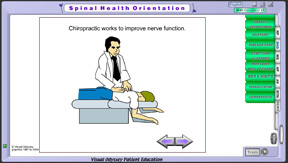 |
|
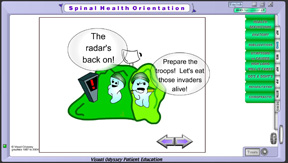 |
|
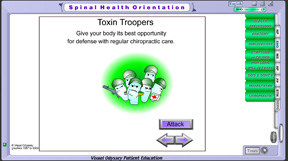 |
|
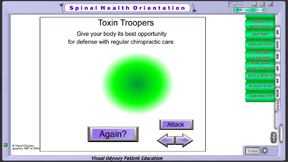 |
|
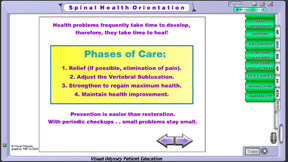 |
Next, we have a page on “phases of care” that gives you the opportunity to talk about the fact that often times health problems develop over time and so it’s reasonable to think it will take time to heal them. It also gives us the opportunity to talk about phases of care themselves. We are interested in the beginning to help you relieve your pain and eliminate as much of it as possible. Chiropractors do that by adjusting the veritable subluxation, and then, by the next phase, we work to strengthen your body so you can hold the adjustments and help you regain your maximum health, and the last stage of this, is the wellness stage where we focus on maintaining the health improvement that we’ve gained. Prevention is always easier than restoration so it’s important that people understand that just like going to a dentist for periodic checkups so they can catch problems while they’re still small. That also makes sense with chiropractic and with their spinal hygiene as well. |
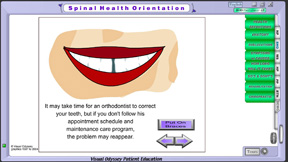 |
The dental, or orthodontic example shows that if you put on braces, those braces help you achieve a correction. But, if you remove the braces before the body has had the opportunity to strengthen and hold those teeth in position, then you will, overtime (maybe slowly) lose the correction you had when wearing the braces. |
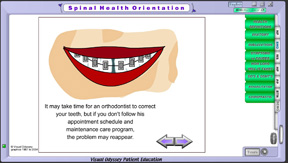 |
Then, as you put the braces on, you follow through on the program and now you are wearing a retainer to hold the correction for a longer period of time. Your body will have the opportunity to strengthen itself to retain that correction and maintain that correction on its own. Take the retainer off too soon, you will still lose correction (although it may take longer), because your body hasn’t learned where those teeth now belong so it will move them back to where they were originally. |
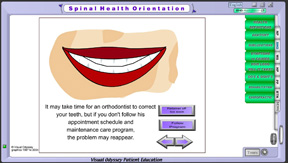 |
|
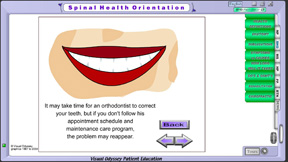 |
|
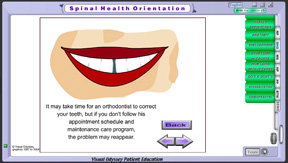 |
|
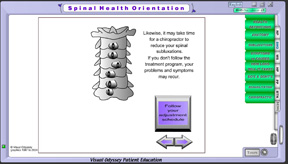 |
We then show the same thing dealing with subluxation. If you follow the adjustment schedule that is designed for your problem, then we can reduce the subluxations. But if we discontinue care before the body and the muscles have had an opportunity to learn how to hold that structural realignment, then we will lose it. This is not unlike taking symptomatic drugs dealing with the symptom of the subluxation rather than the structural realignment that will lead to greater health in the long run. |
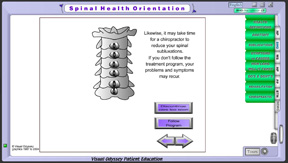 |
|
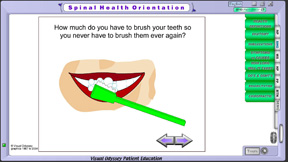 |
Then we have the tooth brush analogy. At what point in your life have you brushed your teeth enough that you don’t need to brush your teeth ever again? While you’re living that never happens. The same thing is true with having your spine checked because people are always doing things with their lifestyle, like crossing their legs, holding the phone with their neck, wearing a thick wallet in their back pocket, driving for long periods of time which is a one-sided thing using their right leg for the accelerator. You will find that your body is constantly adjusting to these lifestyles, and as a result, it is important that you go for periodic Chiropractic checkups. |
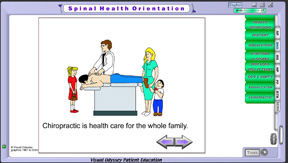 |
|
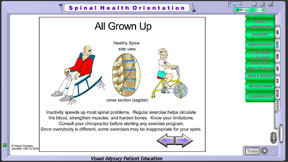 |
The “All Grown Up” section is where we deal with degeneration. It also gives the chiropractor an opportunity to talk with the patients, especially the elderly, about the importance of being checked out before embarking on an exercise program, “to be sure that you’re not going to be causing more harm than good.” |
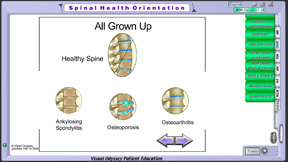 |
We demonstrate three different types of degeneration: Ankylosing Spondylitis, Osteoporosis, and Osteoarthritis. You can click on Ankylosing Spondylitis and you can show how discs and ligaments fuse together to form a calcified bone. |
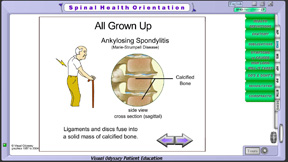 |
|
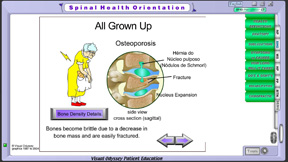 |
We click the right arrow and we talk about osteoporosis, click on the picture of Osteoporosis or the button that says “bone density details.” As you click on the four pictures on the left, you can show four different stages of bone health from normal bone density all the way to serve osteoporosis. This is very valuable, especially if you’re using one of those bone densities machines, because this helps people understand how much bone density they actually have. It’s also very valuable for you to know what to do regarding adjusting them and how much osteoporosis they have. |
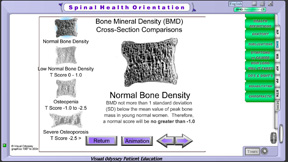 |
|
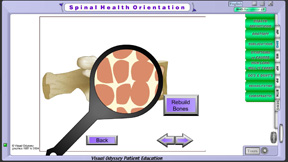 |
The “animation” button shows demineralization of the bone, and some of those “bridges” have actually been broken through, even if you go on a program of remineralizing through nutrition, you may be able to build up some of the bone tissue, but you will not be able to build up that tissue that has already been disrupted where the bridges themselves have been broken. If you click the “back” button and then the “return” button back into the degeneration program. Clicking the arrow we can demonstrate with osteoarthritis and bone spurs as part of the degenerative process. |
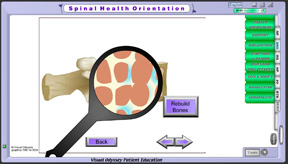 |
|
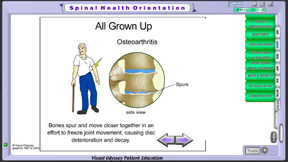 |
|
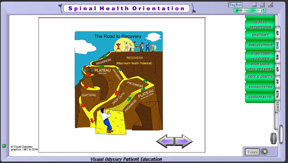 |
The next screen is our “road to recovery” screen and this is based (like so many of these other images) upon one of the posters from our SHO flip chart. This is a very powerful way to help people understand that even the process of finding chiropractic care can be lengthy and allow problems to get worse over a period of time. |
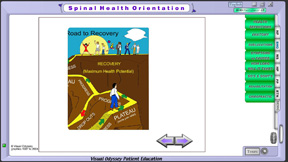 |
The initial stages of care are going to be more frequent or “more rocky” possibly while bodies are beginning to respond to the proper chiropractic care and the adjustments of the subluxations. This also helps people understand that there will be times when they are either feeling a little more sensation in an area which could actually make it a little more uncomfortable, and they will have to decide whether to continue care or drop out. |
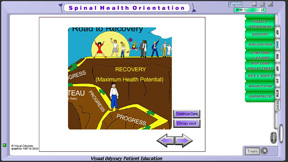 |
|
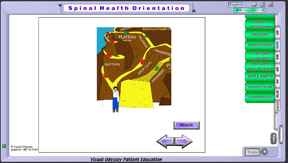 |
By dropping out, of course, they’re not giving themselves the opportunity to experience any kind of real improvement, but by continuing care, they get to the next plateau where possibly they have a tremendous reduction of symptoms (which is probably what brought them into the office in the first place). |
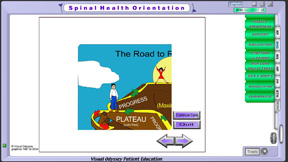 |
Then, they have a choice to determine what health they want, either based upon their symptoms or based upon true functional health. If we continue care here, instead of quitting, we have a better chance of getting to the point where we are truly functionally better and as a result we can have maximum health improvement maintain that through a proper wellness program. |
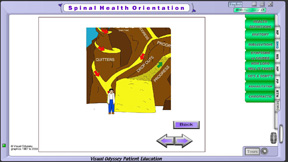 |
|
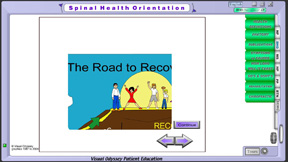 |
|
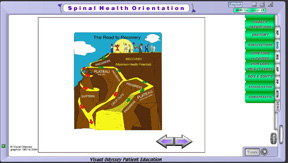 |
|
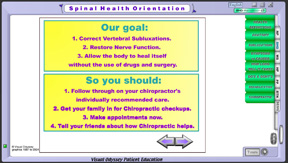 |
Talk about the goals of the office: to locate subluxations, and restore as much nerve function as possible, to allow the body to heal itself without the use of drugs and surgery. The patient has a responsibility to the office. |
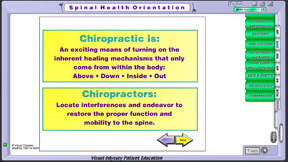 |
The first responsibility is to follow through on the recommended care. If they don’t, then they can’t possibly expect to get the results that they have come in for initially. Unfortunately, human nature says that whether people are responsible for their own health problems or not, they frequently look to blame others, and in this case they’re often going to blame you, the chiropractic office for not resolving their problem when in fact it was their own lack of compliance that caused it. |
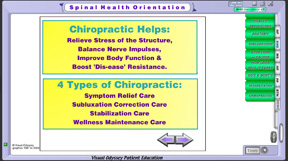 |
The next thing they need to do is get their family to come in for chiropractic checkups. Is it really okay for them to be coming in for care while their children are having all kinds of problems because of sports injuries or things that happened on the playground that aren’t being dealt with? It is very important now to be making appointments rather than procrastinating and allowing small problems to become much bigger. Isn’t it appropriate to let your friends know about chiropractic when you’re getting great results? So, please tell your friends to come in for checkups as well. |
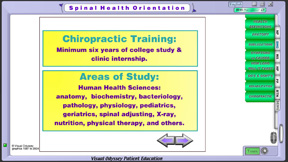 |
|
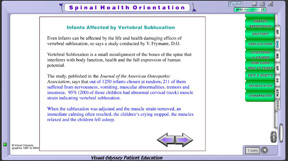 |
|
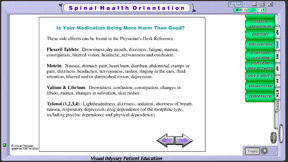 |
|
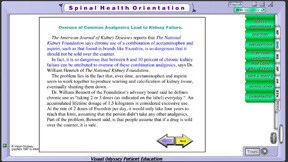 |
|
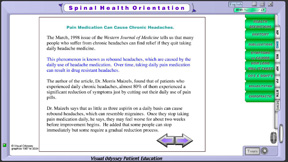 |
|
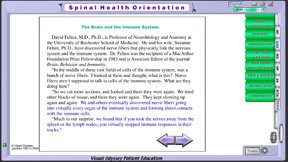 |
|
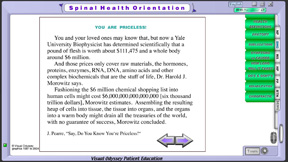 |
|
| |
|








































































































































































